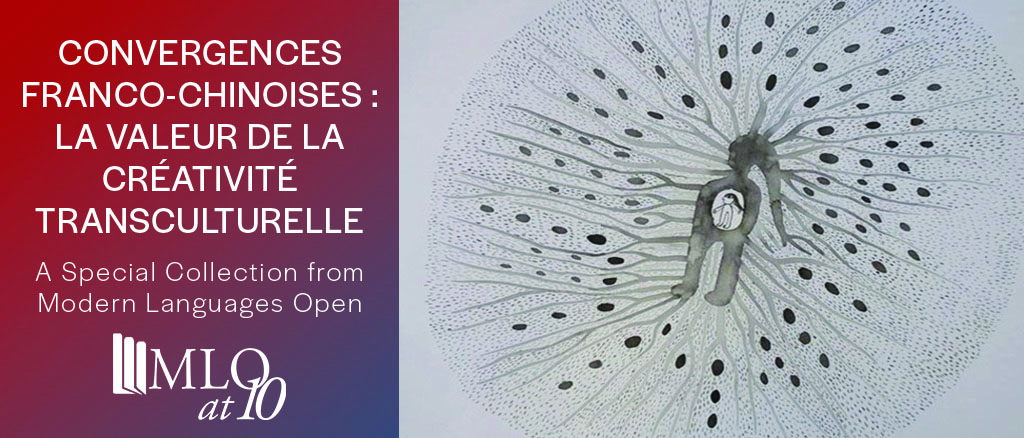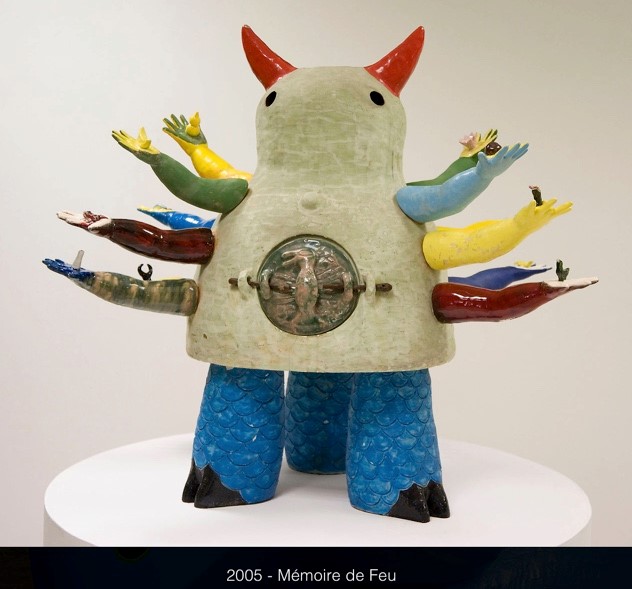
We are delighted to introduce ‘Convergences Franco-Chinoises: La Valeur de la Créativité Transculturelle’, the latest special collection from Modern Languages Open which is available to read Open Access. Taking into account the evolution of world public opinion towards China, this study reveals new trends in the creative practice of Franco-Chinese artists and in the field of research, as well as the growing role of the visual arts. This Special Collection is edited by Dr Rosalind Silvester, Queen’s University Belfast, who introduces the Collection, with her thoughts on the contemporary field of Francophone Chinese Studies.
The relationship between France and China over the last twenty years has been affected negatively by what have become obvious, ideological and geopolitical differences. It is in this difficult socio-political context that this collection is situated. The introduction explores the evolution of international public opinion towards China as the backdrop for the creative practices produced by francophone Chinese writers, artists and other creative practitioners. Relating to the same period, it also discusses the development of the field of research, involving new approaches based in the Medical Humanities, Food Studies, zoopoetics, ecocriticism, visual arts, intermedial studies and literary criticism.
While acknowledging that Francophone Chinese Studies revolves around the negotiation between two contrasting cultures, which leads to a situation in which the authors and artists assume an ‘in between’ position, the collection recognises that they experience more complex and plural realities. For this reason, some of the articles refer to countries beyond the borders of mainland China, to Taiwan and Hong Kong, for instance. Two articles, in particular, emphasize explicitly the value of the transcultural in relation to these plural interactions. Michelle E. Bloom affirms, in her chapter about the Parisian restaurant ‘Yam’tcha’, that the field of Francophone Chinese Studies is multidirectional and much more multidisciplinary than expected because it stretches beyond the presence of Chinese writers and artists in France. She considers the Michelin starred restaurant as the incarnation of the marriage between French and Chinese ingredients and methods. While the chef, Adeline Grattard, is French, her husband Chiwah Chan, the tea sommelier, originates from Hong Kong. Through a unique mixture of French and Chinese flavours, they produce a culinary transculturalism that stresses the plurality of the francophone and sinophone, the hybridity of food habits, and the multifaceted, rather than binary, nature of the restaurant’s cuisine. Along similar lines, Jean-Baptiste Bernard traces the plural identities that are revealed in recent Sino-French graphic novels and bandes dessinées. He describes how publications connected to China are increasingly popular in the francophone world, whether concerning Chinese authors translated into French, francophone authors travelling in China, Chinese authors settling in francophone countries, or francophone authors with Chinese origins. After introducing this dynamic and transcultural phenomenon, he goes on to discuss editorial trends and then the works of certain authors, namely Chen Jiang Hong, Li Chin-Lin and Kei Lam.
The second section of this collection reflects on cultural production as a transformative act putting the inner world of the migrant writer into a meaningful relationship with the outside world, whether human or non-human. Three articles focus on questions of communication and transmission. The first, by Julia Pröll, shows how a migratory aesthetics succeeds in transforming the massive wound of exile into a ‘half opening’, in the sense proposed by Levinas. But, instead of emphasising the emergence of rhizomatic identities (Glissant), it draws attention to the strictly transcultural and transdisciplinary vision of medicine that François Cheng, Ya Ding and Dai Sijie demonstrate in their texts. Pröll examines how the texts, through descriptions of symptoms and the aetiology of illnesses or therapies, interweave western and eastern imaginaries which leads to a questioning of cultural systems of care.

Following this, Gabrielle Parker examines the value of transcultural creativity and the notion of transmission, whether from life to writing, one culture to another, or one generation to the next. She observes that Ying Chen, a plurilingual and nomadic writer, resists the simplistic idea of being a transnational writer who represents a ‘bridge’ between cultures and notes how she, instead, values reciprocity, produced by the continual exchanges between cultures and contexts. In her writing, Chen is particularly interested in cultural and linguistic dislocations and the transmission of her transcultural perspectives and memories, and this double preoccupation is especially evident in her essays, one of which – La Lenteur des montagnes (2014) – is the focus of Parker’s article. Considering not only the relationship between cultures, but also between the human and non-human worlds, Shuangyi Li examines L’Acrobatie aérienne de Confucius, Dai Sijie’s novel which is supposedly inspired by anecdotes from the life of Emperor Zhengde from the Ming Dynasty. With its audacious theme, heterogeneous narrative style and carnivalesque humour, it represents the author’s most experimental work so far. Li analyses the textual and transcultural performances of Dai’s explorations of sex and sexuality, both of animals and human beings, while addressing questions of race and species.
The third section of the collection observes and evaluates the increasingly important role of the visual arts within franco-Chinese artistic convergences. This is mainly attributed to an opening up to the global art world of Chinese-born artists who have moved to France. Whether indirectly or directly, as explained in two articles, these artists resist representative art, having evolved away from traditional, Chinese art and adopted the deconstructive position of post-modern art that is often found in the West. Guillaume Thouroude analyses the works of Chen Xuefeng through the lens of Gaston Bachelard’s philosophical writing, focusing particularly on the symbolic dimension of her works and their materiality. Born in Yunnan and living now in Lyon, the artist draws on her personal and intimate experiences of life to create universal objects which bring together the traditions of south-east China and French autofictional expression. Chen’s works not only create a dialogue between traditions, but also reveal the dialectics of the themes and materials at work. Continuing with this contemporary and figurative perspective on art, Rosalind Silvester’s article looks at the installation art produced by Wang Du, Shen Yuan and Chen Zhen that incorporate waste. This leads her to reflect on the aesthetic value of rubbish in the context of two theories of cultural production –the anthropology of rubbish and the cultural history of waste. She explores its re-evaluation as both an object of art and as a socio-political statement about the environment in the artists’ creations.
All the contributions are primarily concerned with the idea of convergence: connecting individuals, crossing cultural spaces and conveying the trans-position of being. They propose – ambitiously – that the literary, visual and culinary arts may serve to change reality and therefore transform life: in other words, interacting with one another has the potential to become a transformative practice.
Articles in the collection
Available Open Access
Introduction à « Convergences franco-chinoises: la valeur de la créativité transculturelle »
by Rosalind Silvester and Guillaume Thouroude
‘Beyond Franco-Chinese Culinary Crossover: A Marriage of Methods and Ingredients at Yam’Tcha, Paris’
by Michelle E Bloom
‘Du passage des cultures aux identités plurielles : bandes dessinées et romans graphiques sino-francophones’
by Jean-Baptiste Bernard
‘Transcultural Memories and Transmission: The Case of Ying Chen’s La Lenteur des montagnes’
by Gabrielle Parker
‘La création franco-chinoise dans sa matérialité. Le symbolisme dans l’œuvre plastique de Xuefeng Chen et son rapport à la matière’
by Guillaume Thouroude
‘The Value of Rubbish in Francophone Chinese Art Installations’
by Rosalind Silvester
Enjoyed this? You might like:
In Praise of… Charles Forsdick, Drapers Professor of French at the University of Cambridge.

Follow us for more updates
Sign up to our mailing list
Twitter | Instagram
www.liverpooluniversitypress.co.uk
